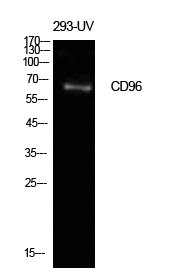产品名称
CD96 Rabbit Polyclonal Antibody
别名
CD96; T-cell surface protein tactile; Cell surface antigen CD96; T cell-activated increased late expression protein; CD96
蛋白名称
T-cell surface protein tactile
存储缓冲液
Liquid in PBS containing 50% glycerol, 0.5% BSA and 0.02% New type preservative N.
Human Gene Link
http://www.ncbi.nlm.nih.gov/sites/entrez?db=gene&term=10225
Human Swissprot No.
P40200
Human Swissprot Link
http://www.uniprot.org/uniprotkb/P40200/entry
Mouse Gene Link
http://www.ncbi.nlm.nih.gov/sites/entrez?db=gene&term=
Mouse Swissprot No.
Q3U0X8
Mouse Swissprot Link
http://www.uniprot.org/uniprot/Q3U0X8
Rat Gene Link
http://www.ncbi.nlm.nih.gov/sites/entrez?db=gene&term=
Rat Swissprot Link
http://www.uniprot.org/uniprot/
免疫原
The antiserum was produced against synthesized peptide derived from the Internal region of human CD96. AA range:291-340
特异性
CD96 Polyclonal Antibody detects endogenous levels of CD96 protein.
稀释度
WB 1:500 - 1:2000. ELISA: 1:10000. Not yet tested in other applications.
宿主
Polyclonal, Rabbit,IgG
背景介绍
The protein encoded by this gene belongs to the immunoglobulin superfamily. It is a type I membrane protein. The protein may play a role in the adhesive interactions of activated T and NK cells during the late phase of the immune response. It may also function in antigen presentation. Alternative splicing generates multiple transcript variants encoding distinct isoforms. [provided by RefSeq, Jan 2016],
组织表达
Expressed on normal T-cell lines and clones, and some transformed T-cells, but no other cultured cell lines tested. It is expressed at very low levels on activated B-cells.
细胞定位
Membrane; Single-pass type I membrane protein.
功能
developmental stage:Expressed at low levels on peripheral T-cells and is strongly up-regulated after activation, peaking 6 to 9 days after the activating stimulus.,disease:A chromosomal aberration involving CD96 is associated with C syndrome [MIM:211750]. Translocation t(3;18)(q13.13;q12.1). CD96 gene was located at the 3q13.13 breakpoint. Precise structural analysis around the breakpoint showed that the gene was disrupted by the translocation in exon 5, probably leading to premature termination or loss of expression of CD96 protein. No gene was detected at the chromosome 18 breakpoint.,disease:Defects in CD96 are a cause of C syndrome [MIM:211750]; also called Opitz trigonocephaly syndrome. This syndrome is characterized by trigonocephaly and associated anomalies, such as unusual facies, wide alveolar ridges, multiple buccal frenula, limb defects, visceral anomalies, redundant skin, psychomotor retardation and hypotonia.,disease:Defects in CD96 are a cause of C-like syndrome [MIM:605039]; also called Opitz trigonocephaly-like syndrome. The C-like syndrome seems to be a severe form of the C syndrome. It is controversial whether there is (1) a gradient of spectrum in the C syndrome, from the mild form (C syndrome) to the severe form (C-like syndrome), or (2) genetic heterogeneity among the patients with the C syndrome.,function:May be involved in adhesive interactions of activated T and NK cells during the late phase of the immune response. Promotes NK cell-target adhesion by interacting with PVR present on target cells. May function at a time after T and NK cells have penetrated the endothelium using integrins and selectins, when they are actively engaging diseased cells and moving within areas of inflammation.,similarity:Contains 1 Ig-like C2-type (immunoglobulin-like) domain.,similarity:Contains 2 Ig-like V-type (immunoglobulin-like) domains.,subunit:Homodimer; disulfide-linked. Interacts with PVR.,tissue specificity:Expressed on normal T-cell lines and clones, and some transformed T-cells, but no other cultured cell lines tested. It is expressed at very low levels on activated B-cells.,
纯化
The antibody was affinity-purified from rabbit antiserum by affinity-chromatography using epitope-specific immunogen.

.jpg)
